 |
||
|
||
| ||
IntroductionOur readers already know sound cards on the YMF724 and the YMF744 chips from Yamaha. The market, however, offers many boards also on the last chip of the series - the YMF754. One of such boards, AW754 from AOpen (www.aopen.com.tw) will be considered today. Here, we will touch some issues that were missed in the previous reviews both on the YMF7x4 chipset series and on sound cards as a whole. AOpen AW754The card we managed to put our hands on was an OEM variant (in a packet with only a CD). 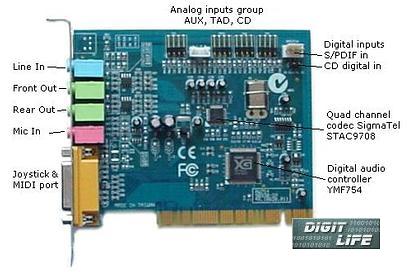 This is the lightest and cheapest board variant. There is no a digital optical output though there is a place for it (an optical output can be found only on the AOpen Pro/Deluxe models). In fact, this board can be completed with a daughter board from AOpen with digital inputs that connect to S/PDIF in. At least, my board properly worked with all digital inputs, and there were no any blockages in drivers. Technical characteristics
What's interesting inside the YMF754?The audio chip YMF754 (named DS-1E) is a high efficient audio controller (in terms of the AC'97 standard) for the PCI bus. The chips consists of two separate functional blocks - PCI Audio and Legacy Audio (such scheme is typical for the whole 7X4 series): 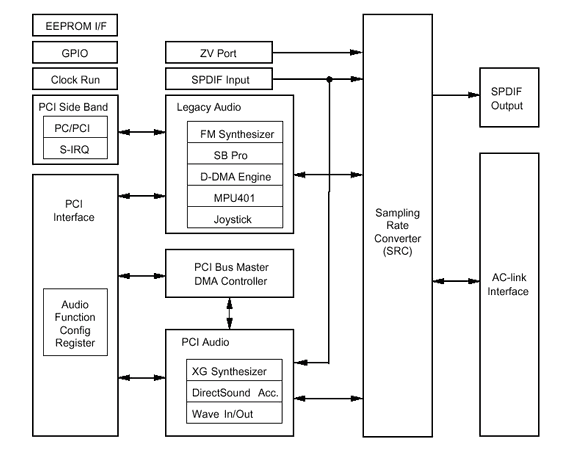 The PCI Audio block provides 64 voices polyphony for the hardware XG wavetable synthesizer (the bank is the same as in the whole 7x4 series, i.e. appr. 2 MB which can be easily unpacked up to 6 MB) and effects (reverb, chorus, variation) realized in drivers. The same block provides DirectSound acceleration. The Legacy Audio unit supports different additional functions. Such as a FM synthesizer, Sound Blaster Pro compatibility, support of the MIDI port (MPU401) and joystick. All these functions are supported in a "clear DOS", according to Yamaha, theoretically without a need in any drivers. The YMF754 is designed in a full accordance with the Intel AC'97 standard. That is, it connects with the AC'97 codecs through the AC-Link bus, and allows using different variants for board layout - both with one stereo output and with two (onto the front and rear speakers). Do not ask us what chip is better at reproduction - the 754 or 724/744, Vortex or EMU10K. None of these chips can not reproduce music, and influences the reproduction quality only indirectly (if only chip don't kill quality of sound initially in digits). The matter is that the last three years all new sound chips are separated from the converters (ADC and DAC) with a digital bus AC-Link: 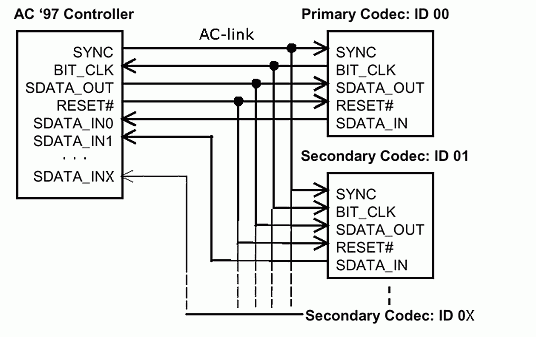 So, the question on comparison of sound quality, say Live! vs. Vortex2, in general can be converted into the question: "What sounds better - SigmaTel or SigmaTel?" :) More competent investigation how different elements of the digital-analog chain influence the sound quality with precise quantitative measurements will be considered in my nearest articles. The 744 and 754 support either one stereo codec or two stereo codecs, or one 4-channel codec (like on this board). It means that 6-speaker board on the 7X4 is impossible. By the way, the AC-link frequency due to the AC'97 standard is fixed at 48 KHz. So, all signals of different frequencies (22, 32, 44,1 KHz etc.) on the chips output are converted in a single 48 KHz speed. This frequency was set by Intel when developing the specification with DVD orientation. All AC'97 codecs run at it. In theory, it doesn't make problems to convert 44.1 to 48 KHz without resampling (according to the experts, such mode is set in some relatively expensive receiver-transmitters). It's necessary to put a buffer on the receiving part and to transmit 44.1 with a higher speed, and then in the codec to "assemble" the signal. But they don't use this scheme in cheap sound cards. Once interpolated with good mathematics on modern DSP locating in audio-controllers, and adding pseudo-noise you can reach rather fair results which should not be audible even on average Hi-Fi acoustics. For seven most popular frequencies which are derivative from 44.1 and 48 such converting (SRC - sample rate converting) is earnestly recommended by the AC'97 to implement hardwarely, on the level of a pair audio controller/audio codec. Let's consider the construction of a modern codec and what it allows connecting inside and outside the computer:
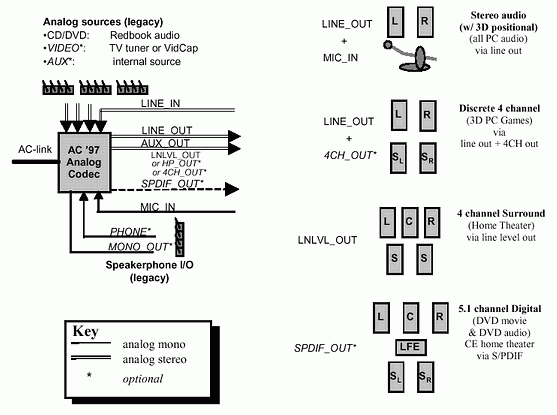 As you can see, all analog out/inputs come to the codec. It means that it is the codec that first of all determines how the card sounds. As for digital outputs (both electrical RCA S/PDIF and optical Toslink), despite the shown Intel scheme, the drop cable usually goes from an audio controller, i.e. a sound chip. And in this case, the signal goes from the 77-th pin of the YMF754 to the place for the connector. Unfortunately, the given board modification doesn't have such. I tried to solder it myself (in fact there should be an optical output), but the SBLive!4830 connected by such a strange way couldn't see the signal.
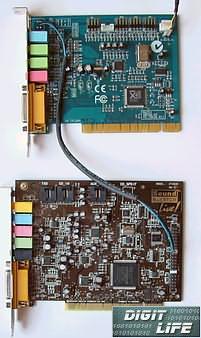 That's why it's more reliable to buy a board with a factory mounted digital output. Let's, however, come back to our YMF754. Where is it better than its predecessor in terms of electricity? Like the 744, it supports the IEC958 standard of the digital interface SPDIF. Unlike the YMF744B (DS-1S) chip, the 754 supports the direct record from the SPDIF In, and at the same time it doesn't take SPDIF In resources when the Zoomed Video Port is operating. Besides, Yamaha states a considerable difference in power consumption. It turned out that the 754 consumes much less energy even at usual operations, not taking the Standby mode. The DS-1E supports PC/PCI and D-DMA protocols for DMA emulation in the style of the SB Pro on the PCI bus. Besides, it supports an old system of interruptions that use the ISA bus and the Serialized IRQ protocol. It ensures support for all games in DOS and says that the chips was worked out 3-4 year ago when it was actual. But as for me, it wouldn't play under DOS; you'd better do it in Windows, in DOS-window, with a more pleasantly sounding of the integrated in the card XG MIDI-synthesizer (if you have a General MIDI option in the game). Installation and complete utilitiesEnough of theory until it is too boring. Since the card can never be called a Hi-End product, I got prepared to the fight with drivers, just for case. Surprisingly, none of the driver's part caused a trouble. And after rebooting, when entering the Windows there appeared the following screen: 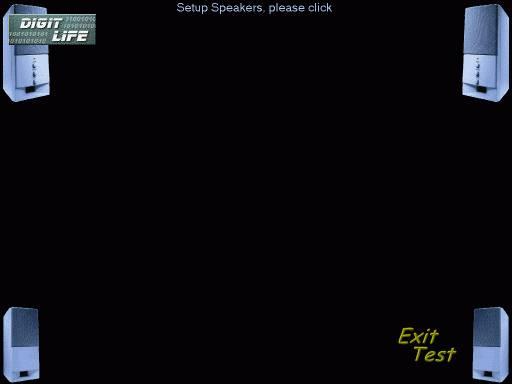 It means that you can immediately check the acoustics connection and card's working capacity.  he tray showed me a proprietary AOpen sign, which I want to say some words on. It's no secret that many companies try to embody something unusual in their utilities. Well, this was the first utility for the last year in the tray which I didn't desire to chuck out. Take, say a standard utility DS-XG Audio Config from Yamaha called out when choosing the option AW754 Config, accessible also from the Control Panel (note that the shown picture, for the space to save, is an animated GIF, for viewing you should enable this option in the browser):  The most interesting is the proprietary utility AOpen AW754 Advanced Options that contains settings and diagnostics of digital in/outputs work (here, we also used the animated GIF): 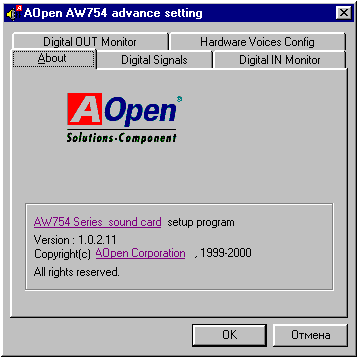 Note a convenient possibility to check whether new drivers were released with just a double click: 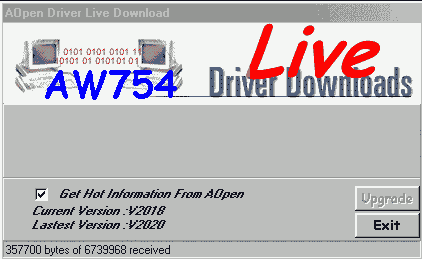 And in case a new driver is found, the utility suggests downloading it to your computer (selecting the server out of the list):  Shortly, it is a good service for little money. Testing the sound qualityNow you know that sound quality is determined mainly by the codec and its analog part on the board (mainly, linear buffers, operational amplifiers and capacitors). The codec used on the board turned to be our old friend - the SigmaTel STAC9708. Well, if they weren't afraid installing this codec in the Aureal SuperQuad Digital and not so long ago released Creative SBLive! Platinum 5.1, there is a chance that sound from the codec wouldn't differ much from the more expensive sound cards. The codec layout is made to be minimum, what carries both highs and lows. Below you can see a spectrogram of comparison of the AOpen AW754 and my reference SBLive! Value 4830 (the Creative CT1297-TAT codec and the Philips 1330A - front and rear correspondingly). Rewriting of the signal via the codec's mixer. The 15KHz@-3 dB sinusoid was created in the SoundForge 4.5.  The spectrogram shows that noise floor of the codec of the AOpen AW754 is located very close to that of the Live codec which is in the Digital Only mode (when adding pseudo-noise to the signal). I'm not going to make measurements from the linear output to the linear input, since the input characteristics of the ADC would damage quite a good DAC. Judging even by the specification, the Signal-to-noise Ratio (EIAJ CP-307) is: D/A 85 dB A, A/D 75 dB A. When listening to the AW754 we haven't noticed any artifacts. The board showed rather decent sounding on the wooden speakers Radiotechnika S-30B (30 W RMS at 8 Ohm, 50-20000 Hz +-10 dB) and the amplifier ODA-102 (two-piece, transistor, 10 W). If you have something similar or at least not better in sounding than the wooden system of the entry level, this card will be a nice choice for you. Further tests on the Onkyo TX-DS484 receiver (DD5.1, DTS, DACs 24bit/96KHz, 5x75W RMS 6 Ohm, 5Hz-100KHz +0..-3 dB) and english Hi-End speakers JPW ML510i (2x75 W RMS, 6 Ohm, 89 dB/W per meter, 60-22000 Hz +-3 dB) 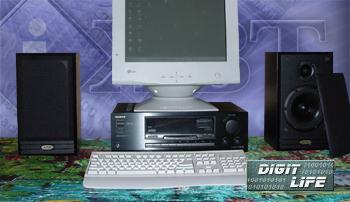 didn't reveal any troubles. Sound nuances of the AW754 from the linear output were dull and flat like that of the most computer sound cards (the sound went out simultaneously from the computer and in digital form, for comparison, at the instant commutation of the signal source from the remote-control on the receiver). I wish I could have given a digital signal and assessed the quality of work of the hardware SCR integrated into the 754 chip. Unlike many top manufacturers, AOpen supplied its product at least with a evaluation version of the WinDVD (at least, the test sample had it). The sound track in DVD movies was well decoded by the soft players WinDVD 2.2 and PowerDVD 3.0. There was nothing to complain about in terms of sound. But today, I think, it's already time to see 6-speaker solutions in this price niche. A bit on game possibilities of the card. As an any normal man, I don't care how many bits have codecs on the board if it plays mono and makes noise. Or how many DirectSound streams it supports if the sound is like from a gramophone. Here, the quality of 3-dimensional sound in games was determined by one word - Sensaura. If you know it, you'd understand me. The others would hope that in a cheap solution one can combine all popular 3D interfaces without performance and quality sacrifice. As for me, I prefer only one game where the EAX 1.0 via the Sensaura algorithms checks itself perfectly and outperforms the well-known A3D on the Vortex2, with its unfinished emulation EAX. The game is Crusaders of Might & Magic (by the way, made quite dull). In order to enjoy 3-dimensional effects you have to download a demo from the Internet (it looks like Diablo 1, but in 3D). Those of you who possess a full version of the game should come to the second or third stage since only there you might see dynamic actions and only there we could estimate EAX technology. Together with this card we received standard demo programs from Yamaha with wide-known collections of XG MIDI-files. Besides, you can find them at www.yamaha-xg.com. Once again I want to summarize XG MIDI sounding in the YMF7x4 based card series. It's cool for home, for your family (karaoke, DOS-games) and for beginning home musicians. ConclusionDespite the fact that I started testing this card without great delight, the AOpen AW754 surprised me quite pleasantly, and deserved the mark closer to "must have" than to "must die". Highs:
Lows:
Resume: this product is an excellent budget solution. Maybe, the most universal for such sum. Write a comment below. No registration needed!
|
Platform · Video · Multimedia · Mobile · Other || About us & Privacy policy · Twitter · Facebook Copyright © Byrds Research & Publishing, Ltd., 1997–2011. All rights reserved. |